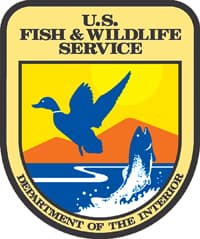U.S. Fish and Wildlife Service Approves Voluntary Plan to Conserve Lesser Prairie-Chickens in Oklahoma and Range-wide

The Oklahoma Department of Wildlife Conservation and its partners are making strides in lesser prairie-chicken conservation, evidenced especially by the recent U.S.
Fish and Wildlife Service (Service) endorsement of a voluntary five-state plan to conserve the birds.
The Lesser Prairie-Chicken Range-Wide Conservation Plan (RWP) is the product of collaboration among the five states in the lesser prairie-chicken range – Oklahoma, Kansas, Colorado, Texas and New Mexico, all members of the Western Association of Fish and Wildlife Agencies. The RWP first evolved from Oklahoma’s own lesser prairie-chicken conservation plan.
“The Wildlife Department and its partners are leading the way in the effort to conserve lesser prairie-chickens,” said Richard Hatcher, director of the Wildlife Department.
“This plan ensures the sustainability of lesser prairie chickens while allowing responsible economic development across the birds’ range. Equally important, it recognizes private property rights and the role that landowners play in conserving habitat.”
Allan Janus, research supervisor for the Wildlife Department and co-author of the plan, said, “The RWP is geared toward conserving the lesser prairie-chicken through financial incentives for landowners to manage their lands in ways that benefit the species. The RWP also provides a framework for mitigating the harmful effects on the bird caused by development activity throughout the range of the prairie-chicken.”
The lesser prairie-chicken RWP represents an innovative model of State leadership in the conservation of an at-risk species proposed for listing under the Endangered
Species Act (ESA). The Service will carefully consider the RWP, its implementation
and effectiveness when it makes the final listing determination on whether or not to list the species. This listing determination is expected in March of 2014.
The RWP encourages landowners to proactively manage property in exchange for financial support. Agreements with participating landowners will aim to improve habitat conditions for the lesser prairie-chicken, increase populations and provide for long-term conservation of the species. The RWP also establishes a framework for mitigating impacts from the wide range of activities covered under the RWP, with a goal of providing a net conservation benefit to lesser prairie-chicken.
The lesser prairie-chicken is a species of prairie grouse commonly recognized for its colorful spring mating display and orange eye combs. Once abundant across much of Oklahoma, Colorado, New Mexico, Texas and Kansas, the lesser prairie-chicken’s historical range of native grasslands and prairies has been reduced. The substantial decrease in the range of the species is primarily a result of habitat fragmentation and loss caused by development and conversion of native prairie grassland habitat to other uses.
The RWP is another example of how Oklahoma continues to lead in conservation measures designed to benefit the lesser prairie-chicken in Oklahoma and across its range.
“Not only have we gained this important endorsement of a range-wide plan that had evolved from Oklahoma’s own plan, but we’re making other strides as well,” Hatcher said.
Oklahoma’s Lesser Prairie-Chicken Spatial Planning Tool, produced in 2007, was the first tool designed to help developers avoid impacting crucial habitat and gave way to a similar range-wide tool (Southern Great Plains Crucial Habitat Assessment
Tool) that also prioritizes conservation actions while assisting with the siting of industry development. Additionally, the Department has already enrolled about
200,000 acres of private land into its Candidate Conservation Agreement with Assurances
(CCAA) program with a goal of reaching 400,000 acres. The CCAA encourages landowners to manage their lands toward the benefit of lesser prairie-chickens in exchange for assurances in the event the bird is listed as threatened or endangered.
“I’m confident that through our efforts, we can demonstrate that a federal listing is not warranted,” Hatcher said.
The Wildlife Department is the state agency charged with conserving Oklahoma’s fish and wildlife. For more information, log on to wildlifedepartment.com.

